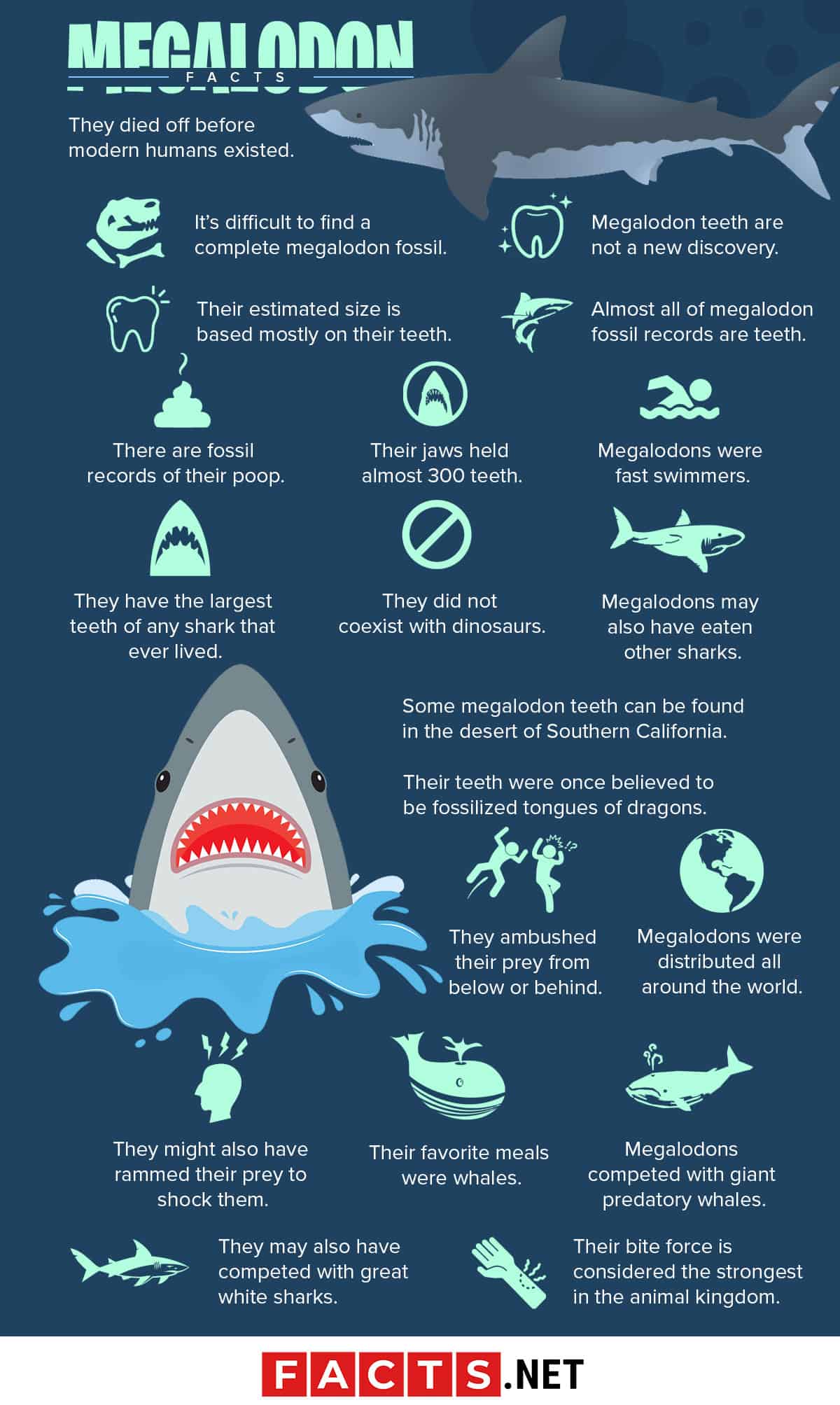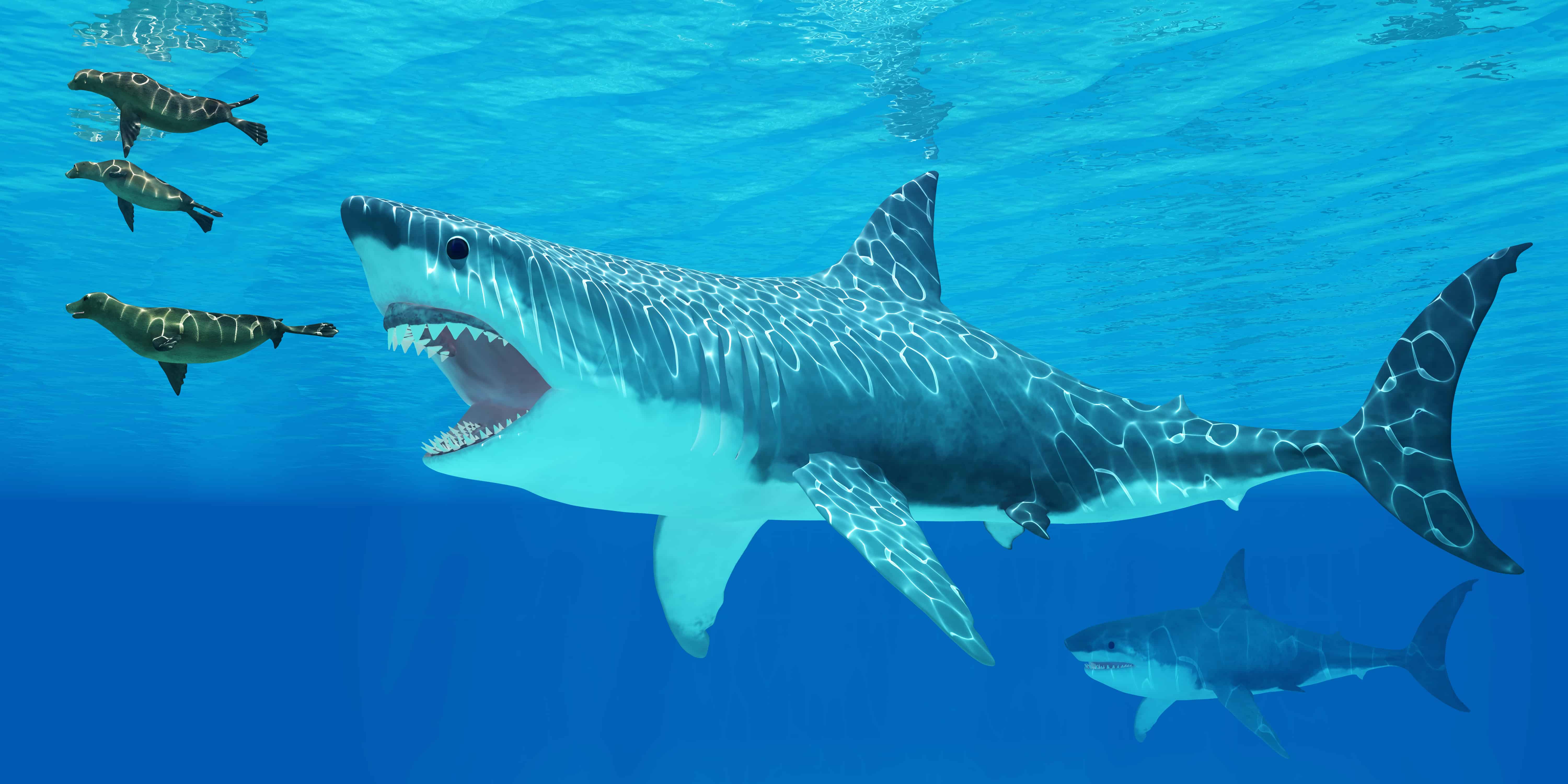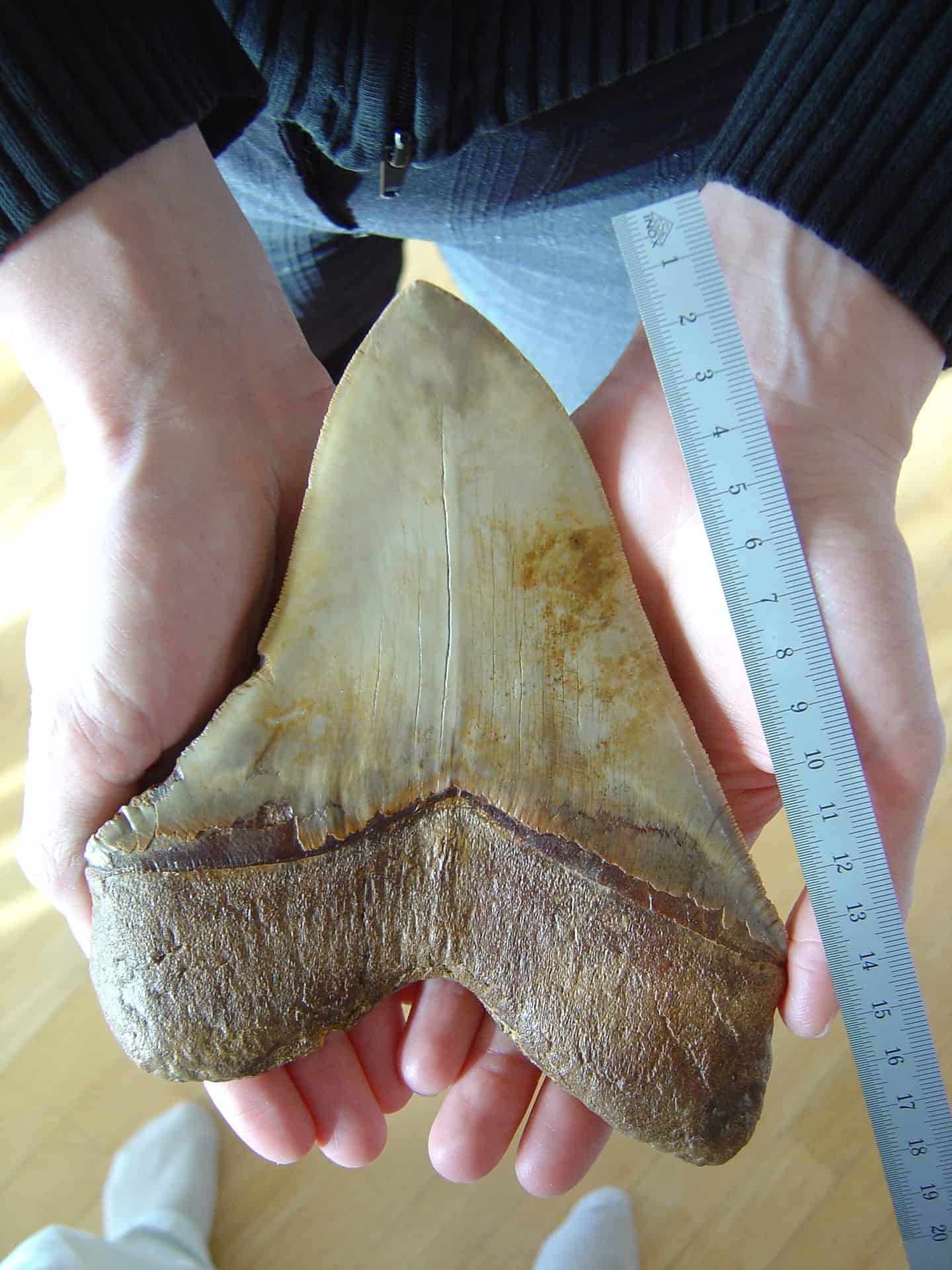
The megalodon ruled the oceans millions of years ago as the largest shark species that ever lived. Nicknamed “The Meg”, these gargantuan hunters are long extinct, but still remain relevant in films and TV shows. Check out these huge megalodon facts to learn more about the now-extinct giant sharks.
- Megalodons are the largest sharks to ever live.
- They were apex predators.
- Their scientific name is Carcharocles megalodon.
- They might also be called Otodus megalodon.
- Megalodons preferred warmer waters.
- The megalodon sharks lived from the Early Miocene to the Pliocene epochs.
- Megalodons may have had small eyes that were deep-set.
- The giant sharks lived for about 20 million years.
- Their bodies may have shared similarities with those of great white sharks.
- One of their genus names, Otodus, means “ear-shaped tooth”.
- Megalodons ranked higher up the food chain than great white sharks.
- They might have eaten 2,500 lbs (1134 kg) of food per day.
- They belong to the family Otodontidae, the mega-toothed sharks.
- The physical appearance of megalodons is still widely disputed.
- They may have died off 3.6 million years ago.
- Scientists haven’t found a complete megalodon skeleton.
- The name “megalodon” roughly means “giant tooth”.
- Although they ventured out into the open ocean, they preferred to be close to shores.
- Female megalodons were larger than males.
- Their mouths were about 10 ft (3m) wide.
Megalodon Facts Infographics

They died off before modern humans existed.
Although some debates exist on when exactly the megalodons disappeared from the oceans, recent research suggests that they went extinct before modern humans evolved. Some researchers suggest that they died off 2.6 million years ago, while some contest that it’s more likely that they went extinct earlier in the Pliocene epoch, around 3.6 million years ago. Early Homo sapiens only appeared in the Pleistocene epoch, 2.5 million years ago.
It’s difficult to find a complete megalodon fossil.
Like modern sharks, rays, and skates, megalodon skeletons were mostly made of cartilage. Cartilage does not usually preserve well and rarely leaves any fossils, so the likelihood of finding a complete megalodon fossil is close to none.
There are fossil records of their poop.
Although fossilized body parts of megalodons are hard to come by, people have discovered some unlikely remains of the colossal sharks. Aside from teeth and some vertebrae, we also have specimens of their feces.
The fossilized feces, called coprolites, are shaped like a spiral. This indicates that the megalodons likely had a spiral valve, a part of the intestines present in modern-day sharks. One coprolite was measured to be 5.5 in (14 cm) in length.
Some megalodon teeth can be found in the desert of Southern California.
You can go fossil-hunting for shark teeth, including megalodon teeth, in the Sharktooth Hill Bone Bed located in the deserts of Southern California. The site also hosts other fossils of marine animals such as whales, turtles, and sea cows. In the Miocene epoch, when megalodons were still alive and thriving, Sharktooth Hill was submerged in water.
Almost all of megalodon fossil records are teeth.
Fossil records of megalodon teeth are abundant because they constantly shed their teeth. It’s not uncommon to find a small or damaged megalodon tooth buried in beaches or embedded in rocks. The teeth are the hardest part of the megalodon’s body and better fossilize than any other part of their body.
Their estimated size is based mostly on their teeth.
Because we currently don’t have a complete skeleton, the megalodon size is extrapolated from the size of their teeth, backed up by some remains of their jaws and vertebrae. Scientists calculated their size using the proportions of modern sharks.
They have the largest teeth of any shark that ever lived.
One of the most well-known megalodon facts is that their teeth were huge. Megalodons were named after their huge teeth, after all. An adult megalodon tooth can reach up to 7.5 in (17.8 cm) in length and can weigh more than a pound (0.45 kg). Megalodon teeth grow three times longer than the teeth of great white sharks. The large, triangular teeth had fine serrations and were built for grabbing prey, tearing meat, and crushing bones.

Their jaws held almost 300 teeth.
A single megalodon jaw had five rows of large, serrated teeth. Like modern sharks, their teeth were susceptible to falling off and thus were constantly replaced. The rows of teeth move from back to front, similar to a conveyer belt. If a tooth falls off, a new tooth will replace it after only around one or two days.
Megalodons had around 276 teeth in their giant mouths. They also grew new ones constantly, making it likely that they went through thousands of teeth during their entire lifespan. Connective tissue fibers held the teeth in place, which scientists believe added to their strength.
Megalodon teeth are not a new discovery.
People have come across megalodon teeth for millennia. Records of megalodon teeth can even be traced as far back as 70 AD, when Pliny the Elder postulated that the triangular shark teeth fell from the sky during eclipses.
Their teeth were once believed to be fossilized tongues of dragons.
During the Renaissance, a good chunk of the population believed that the giant, fossilized teeth of megalodons were fossilized remains of dragon or serpent tongues. The noble people wore these “glossopetrae”, or tongue stones, as decorative pendants or artifacts that bring good luck. They also used the teeth as part of their traditional medicine, said to cure snake bites and other poisons.
It wasn’t until 1611 that the Italian naturalist Fabio Colonna recognized these tongue stones as the teeth of ancient sharks. The Danish naturalist Nicholas (or Nicolaus) Steno backed this up in 1667 when he published his work The Head of a Shark Dissected. In his work, Steno also provided an illustration of a megalodon tooth and what it could have looked like when it was attached to the head of the shark.
Megalodons were distributed all around the world.
Megalodons used to thrive in warmer coastal waters, but they weren’t picky about their territories. The sharks were cosmopolitan, meaning they lived all across most areas of the world. Megalodon fossils have been found in every continent except Antarctica, where it was too cold for the sharks to thrive.
Megalodons were fast swimmers.
Despite the massive megalodon size, they were effective hunters due to their speed and power. Scientists calculated the ratio between typical shark size and speed and postulated that they had an average speed of 11 mph (18 km/h). For comparison, the fastest human swimmers can achieve a top speed of around 5 mph (8 km/h).
They ambushed their prey from below or behind.
It’s easy to spot a giant shark from afar, so megalodons had to adjust and remain unseen. To avoid detection, megalodons stalked their prey from below or behind. They sneak up close then attack, using their massive size as a clear advantage against their prey.
During the hunt, megalodons used different complex strategies to kill their prey. One probable method was to bite off the fins of their prey to ensure that they don’t escape.

They might also have rammed their prey to shock them.
The size and the breakneck speeds of megalodon sharks allow them to easily overpower their prey. Scientists discovered that some of their prey animals had spines broken from impact, suggesting that megalodons rammed their prey to stun and incapacitate them.
The megalodon shark reached its gigantic size because of an abundance of large prey.
At the end of the Mesozoic period, mountain ranges began to form and weather to the oceans, giving enormous amounts of nutrients which increased the amount of plants in the seas. This surge in plants and algae also led to the abundance of large marine mammals, the favorite prey of the megalodon. Because of the abundance of food, the marine mammals (such as whales, dolphins, seals, and manatees) evolved to become larger, and the mega-toothed sharks kept up with this increase in size.
Their favorite meals were whales.
The megalodon fed on large prey to quell their equally large appetite. Fossil records of ancient whales revealed that megalodons used to feast on them. The fossils of their vertebrae and ribs show cut marks from the megalodons’ huge, serrated teeth.
Megalodons competed with giant predatory whales.
The megalodons were certainly tough to beat, but they did have some competition. A giant predatory sperm whale species called Livyatan melvillei shared the same food source as the megalodon. Livyatan melvillei also preyed on pinnipeds and even other whales. It is unclear whether or not these two giants attacked each other, but it’s highly likely that they have fought over food.
Megalodons may also have eaten other sharks.
Megalodons were not restricted to eating marine mammals. They also hunted fish, giant sea turtles, and perhaps even other sharks.
They may also have competed with great white sharks.
Great white sharks have been around for a long time, and they may have competed with the ancient giant-toothed hunters. As the great white shark population began to rise, megalodon numbers began to fall.
The great whites are far smaller than the megalodon, but that means they may have competed with young megalodons. The megalodons and great white sharks occupied the same regions and shared the same food source.
Their bite force is considered the strongest in the animal kingdom.
Megalodon jaws are extremely strong, perhaps even the strongest in the animal kingdom. Researchers estimate that the sharks packed a bite force of around 110,000-180,000 newtons (25,000-40,000 lb), more powerful than the fearsome predator Tyrannosaurus rex.

Despite their similarities to the great white shark, they are not close relatives.
The Meg and the great white shark share some similarities, especially regarding their tooth shape. Because of this, the two species were previously thought to be closely related. However, recent data suggest that the similarities are likely the result of convergent evolution, the phenomenon wherein two distinct lineages evolve similar traits due to having similar niches.
Their closest living relatives are mako shark ancestors.
Researchers found that the closest relatives of the megalodon sharks are ancestors of the mako sharks, which are smaller than great whites.
Megalodons may not have been completely cold-blooded.
Most fish are exclusively cold-blooded, but scientists suggest that megalodons exhibit some form of warm-bloodedness referred to as regional endothermy. Through this adaptation, the megalodons can keep their bodies warmer than the surrounding water. This allowed them to hunt in colder regions. Modern great white sharks also have this ability.
They gave birth to live young.
Scientists believe that megalodons gave birth to live young instead of laying eggs like most fish do. The majority of modern sharks also give live birth.
Baby megalodons were still large.
The thought of a baby megalodon may sound cute in theory, but even young megalodons were still giants. Through analyzing the teeth of young megalodons, experts suggest that the newborn sharks may have been more than six and a half feet (2 m) long.
They had nurseries for their young.
In a study published in 2010, scientists found a megalodon nursery near the coast of Panama. They identified it through the number of young megalodon teeth that they found along the area. Scientists also found similar nurseries in Maryland, Florida, and the Canary Islands.
Similar to modern sharks, warm-water nurseries were vital to the survival of their species. These nurseries had an abundance of food and had shallow water that provided the young megalodons some protection against other large predators.
They did not coexist with dinosaurs.
By the time the megalodons ruled the oceans, the non-avian dinosaurs had been extinct for around 40 million years.
Baleen whales achieved bigger sizes after the extinction of megalodons.
After the extinction of these giant beasts, baleen whales (such as the blue whale and the humpback whale) had fewer predators that could eat them. Because nutrient levels were still high in the oceans, the whales had an abundance of food, allowing them to reach the enormous sizes they have today.
Blue whales still outclass them when it comes to size.
When it comes to size, blue whales are definitely bigger. In fact, blue whales are still uncontested as the biggest animal to ever live on Earth, living or extinct. On average, megalodons grew to about 34 ft (10.5 m) long, with females almost twice the length of males. Some scientists suggest that the largest specimens could have reached up to 82 ft (25 m) in length. In contrast, North Atlantic blue whales have an average length of 92 ft (28.1 m).
Giant megalodon teeth can be found on the market today.
It’s fairly common to find megalodon teeth being sold on the market today. You can buy or sell a small or damaged megalodon tooth for an inexpensive price, but the large, intact teeth are much more expensive because of their rarity. One of the largest, non-restored teeth sold for around $50,000.

A 7-year-old boy found a megalodon tooth on the beach.
In 2017, a 7-year-old boy on a vacation with his family found a large megalodon tooth in Myrtle Beach, South Carolina. The tooth was more than five inches (12.7 cm) long.
Thomas Jefferson once owned a megalodon tooth.
Thomas Jefferson, a US founding father, is a known fossil enthusiast. He collected fossils of mastodons, giant sloths, and even had a tooth of a megalodon. He also put his signature on the megalodon tooth that originated from South Carolina.
There is an extinct genus of clams called Megalodon.
When you’re talking to a marine biologist, you might want to specify what kind of megalodon you’re talking about. That’s because there’s also an extinct genus of bivalves called Megalodon.
Megalodon vertebrae had rings similar to tree rings.
As they grow, the vertebrae or backbones of megalodons grow rings that can be seen in a cross-section view. The rings increase with age, similar to the rings found in cross-sections of tree trunks.
Megalodon teeth had a huge influence on modern geology.
When Danish naturalist Nicholas (or Nicolaus) Steno worked on shark teeth in 1666, he began to wonder how these solid teeth became embedded in solid rocks. He later worked on the formation of rock layers, eventually giving rise to modern stratigraphy.
The teeth have been found stuck in the bones of huge marine mammals.
Scientists found several bones from ancient marine mammals that had markings of megalodon teeth on them, and more fascinatingly, some whale vertebrae still had megalodon teeth embedded in them.
Climate change was thought to play a role in their extinction.
Megalodon sharks vanished around the time of the ice age. One of the hotly-debated megalodon facts is that the colder climate might have killed them off. Scientists once thought that because the sharks preferred warmer waters, they could not have survived the cooling temperatures or could not keep up with the whales that moved to colder waters. Their young also thrived on warmer waters, and the colder Earth might not have been the ideal climate for the baby sharks.
Megalodons could swim even in near-freezing temperatures.
Recent studies suggest that the colder temperatures may not have caused the extinction of megalodons, because they found that the sharks swam in waters as cold as 34 °F (1 °C), a temperature near freezing. It also supported the fact that they were not fully cold-blooded.
They likely died off due to a lack of food source.
While the megalodons most certainly did not freeze to death, they likely starved to death. They faced a lot of competition when it came to food, and a huge chunk of their food source went extinct before them.
Their huge size, which was once their advantage, ultimately became their downfall. They needed a huge amount of food to sustain their enormous bodies, but because food became increasingly scarce and competition became tougher, they weren’t able to meet their needs.
Megalodons are definitely extinct.
The rising numbers of their competitors, together with the dwindling food sources and more scattered populations due to colder climates, might have ultimately caused their demise. Although the certain cause of their extinction is still up for debate, scientists are sure that they no longer exist. This is one of the megalodon facts that most scientists agree on.
Scientists are certain that they are extinct because we haven’t found any fossils younger than 2.6-3.6 million years old. The megalodon sharks shed thousands of teeth, so it’s likely that they would have left a trace if they still existed. They also would leave an enormous impact on large marine animals.
Was this page helpful?
Our commitment to delivering trustworthy and engaging content is at the heart of what we do. Each fact on our site is contributed by real users like you, bringing a wealth of diverse insights and information. To ensure the highest standards of accuracy and reliability, our dedicated editors meticulously review each submission. This process guarantees that the facts we share are not only fascinating but also credible. Trust in our commitment to quality and authenticity as you explore and learn with us.
